The Supreme Court, barely, upholds our three-branch system of government
A bright light — and several dark warnings — in Wednesday's 5-4 vote rejecting the Trump admin's request to toss out a district court order requiring USAID payments.
On Wednesday morning, the U.S. Supreme Court denied the Trump administration’s request to vacate U.S. District Judge Amir Ali’s February 25 order that the State Department and USAID make payments on work done prior to Ali’s February 13 temporary restraining order in which he found that a pause on those payments was likely illegal.
In short, the Supreme Court allowed Ali to move forward with the case and with his order that the government issue payments for work already performed.
More broadly, the Supreme Court’s order supported keeping our three-branch system of government in place, with Congress passing laws — including funding appropriations — and the federal courts enforcing those laws when executive branch fails to follow them.
This was a win for democracy, accountability, and separation of powers.
That’s the good news — the bright light.
And yet.
Although the headlines Wednesday morning were effusive — The New York Times push alert declared that the “Supreme Court rejected President Trump’s bid to freeze foreign aid payments“ — the underlying reality is far more concerning and the order presents several dark warnings about the path ahead.
First, and perhaps most fundamental to understanding the limits of Wednesday’s order, Trump got his way for now — despite the headlines. The payments — required under a February 13 temporary restraining order and explicitly ordered under a February 25 order — have still not been made.
It’s March 5.
It’s very difficult for me to find it appropriate or correct, in those circumstances, to declare that Trump’s efforts have been “rejected.”
The payments may be required in the future, but Ali’s February 25 order enforcing his February 13 TRO, which required payment to be made by 11:59 p.m. February 26, was blocked. It was blocked due to Chief Justice John Roberts’s February 26 stay of Ali’s order — referred to on Wednesday as an “administrative stay,” although there was ultimately nothing administrative about it, as Roberts’s stay remained in effect for more than five days after the deadline set by the district court for the payment.
Or, as the court’s unsigned, one-paragraph order passively put it, “Given that the deadline in the challenged order has now passed ….”
So, the application was “denied” on Wednesday, but, the deadline had passed, meaning it’s back to Ali to issue a fifth order.
Second, this limited vote upholding our three-branch system of divided governing was a mere 5-4 vote, with Justice Sam Alito proclaiming that he was “stunned” by the majority’s decision.
Alito, raising his flag of opposition, was joined in dissent on Wednesday by Justices Clarence Thomas, Neil Gorsuch, and Brett Kavanaugh.
Alito’s dissent, as is becoming the expectation, was the unhinged rant of an increasingly unserious man. To give just one key example, Alito — a former federal prosecutor and appeals court judge who has spent nearly 20 years on the Supreme Court — wrote the following sentence:
After issuing the TRO, the District Judge grew frustrated with the pace at which funds were being disbursed, and on February 25, he issued a second order requiring the Government to pay out approximately $2 billion.
This is false — and materially so. It was not the second order. It was, in fact, the fourth order. It was the third order by Ali reiterating — against repeated Justice Department, State Department, and USAID efforts to push back — that what he ordered on February 13 was what he meant. It was only after continued nonpayment in the wake of the first three orders that Ali, in response to a motion from the plaintiffs in the case, issued the fourth order with a payment deadline.
On that, it is important not to ignore — in addition to his misrepresentation of the facts — that Alito impugned the actions of a federal judge, pretending that we are where we’re at not because of the federal government’s nonpayment and the plaintiffs’ request that the court issue an order enforcing their rights, but instead because Ali “grew frustrated with the pace” of payment disbursal. (In addition, while “nonpayment” is, technically, a “pace,” this is yet another misleading framing from Alito.)
That’s just one sentence of Alito’s eight-page dissent, but the most alarming portion of it is that he wasn’t writing just for himself or even himself and Thomas. No, this was a four-justice dissent.
Which brings us to the third warning.
Halfway into his dissent, Alito wrote, “Even if the majority is unwilling to vacate the District Court’s order, it should at least stay the District Court’s enforcement order until the Government is able to petition for a writ of certiorari.”
This is important because four justices signed on to a statement all but stating that they believed this issue is cert-worthy — the court’s formal way of taking up review of a case on the merits.
Here’s the thing, it only takes four justices to grant cert in a case, while it would have taken a majority to vacate Ali’s order. In other words, while the headlines were about Trump being “rejected” on Wednesday, four justices posted a bright, blaring sign that they would almost certainly force this into more extensive litigation — merits briefing and arguments that can take months or a year — if the Justice Department just brings them the right filing.
Although that wouldn’t automatically lead to a stay during the merits appeal, Alito certainly would be urging Roberts — and likely Justice Amy Coney Barrett — to provide him with a “courtesy fifth” vote to stay the lower court order during the appeal. While this has traditionally come up in death penalty litigation — see this report from Amy Howe for more — I don’t doubt for a minute that Alito would press for some sort of similar step here.
Which brings us to the fourth warning: The majority’s order was not some strong support of the district court’s authority.
To the contrary, in addition to Roberts’s stay having prevented payments, the court’s five-justice majority of Roberts and Justices Sonia Sotomayor, Elena Kagan, Amy Coney Barrett, and Ketanji Brown Jackson gave a bit of a warning to Ali as to what he should do next.
The full sentence that I began above went like so:
Given that the deadline in the challenged order has now passed, and in light of the ongoing preliminary injunction proceedings, the District Court should clarify what obligations the Government must fulfill to ensure compliance with the temporary restraining order, with due regard for the feasibility of any compliance timelines.
In other words, more room for more stay requests, mandamus petitions, and petitions for writs of certiorari.
Finally, the fifth warning Wednesday’s order sent was more of a reminder of the reality of what we should be expecting from the Democratic appointees. The narrow support for enforcing the structural requirements of our government puts additional pressure on the justices who otherwise might be the best placed to publicly voice their concerns with what is happening at the Supreme Court.
Because of the reed-thin five-vote majority here, the trio of Democratic appointees — even if they might have wanted to write on Wednesday — understandably held back.
Even if any of those justices disagreed with the way this went down, the reality of this Supreme Court — and this moment — is that they have to be particularly careful not to alienate any other justice open to upholding and, if needed as we move forward, enforcing our governmental structure.
That can be frustrating, but, with no vote to spare, this is what we get — and likely what is needed for now.
The next steps
Hours after the Supreme Court issued its order, Judge Amir Ali — who already had a preliminary injunction hearing scheduled in the case for 2 p.m. Thursday — issued his own order, making clear that he will be moving forward quickly.
Ali ordered a joint status report to be filed by 11 a.m. Thursday “proposing a schedule for Defendants to come into compliance with the Court's temporary restraining order ("TRO") and the Court's February 25, 2025, order enforcing the TRO.“
Notably, he ordered the status report to include “steps taken” during any time other than during Chief Justice John Roberts’s “administrative stay” and “milestones and timelines” for the government “coming into compliance” with the TRO and February 25 order.
Ali also made clear that these TRO-related compliance questions will be discussed at the Thursday hearing, in addition to the “substantive arguments” over the preliminary injunction request.
Note: This section was added after initial publication, with the final edits made at 2:45 p.m.


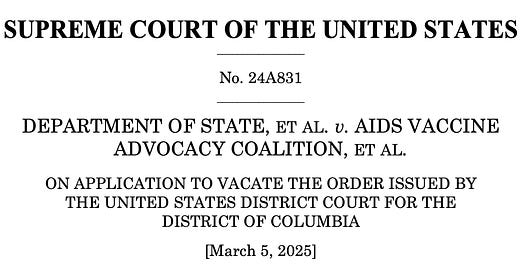



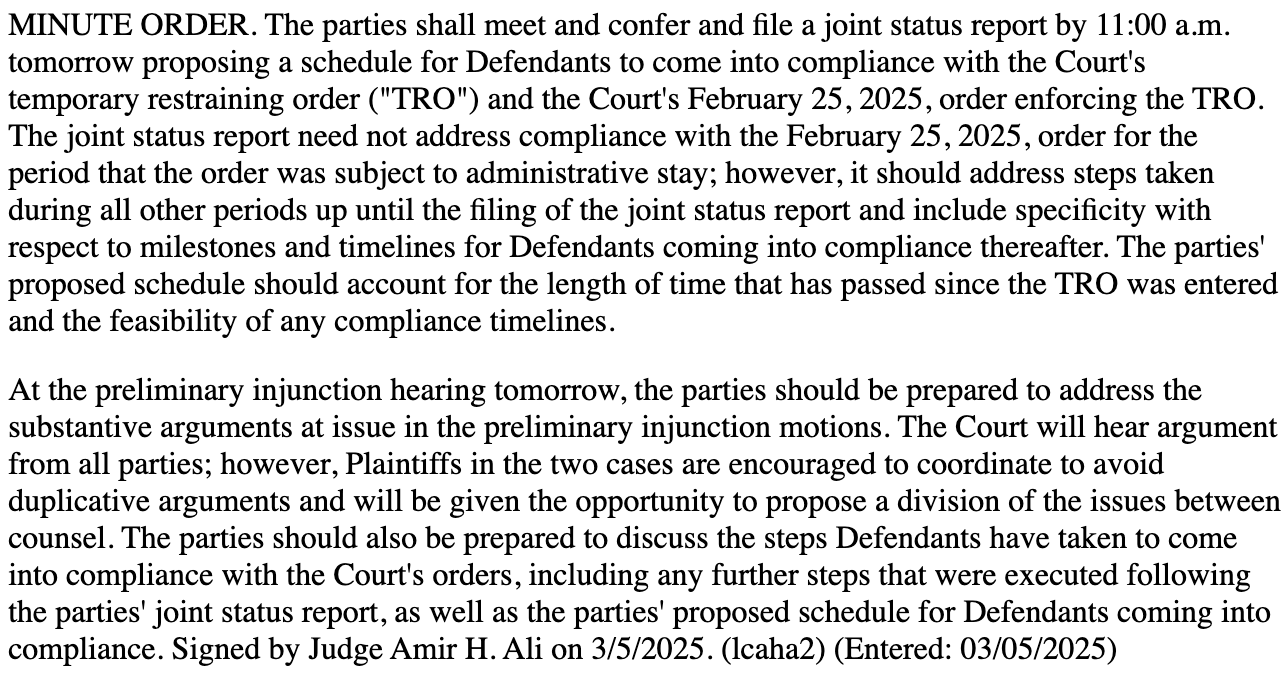





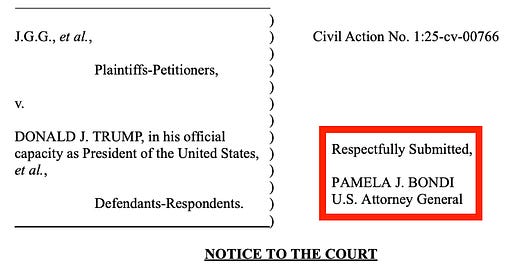

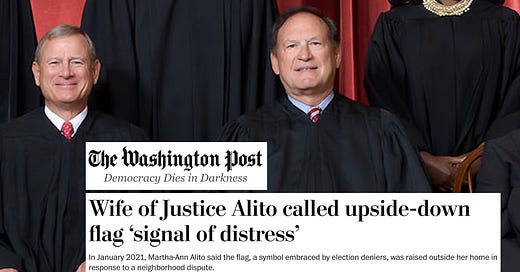

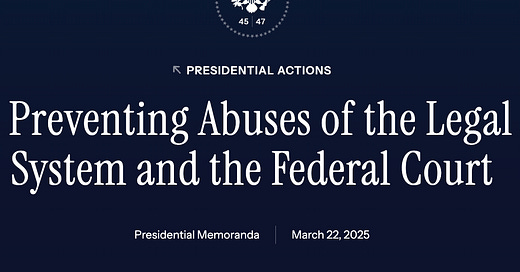

The one consistent thing about Trump is that he doesn't pay his bills (which he touts as evidence of his superior intelligence). Four justices just said that approach is well and good for the United States government. Because what could possibly go wrong? Another justice took several days to think about it. (We don't really know Barrett's opinion on the matter for sure). And yet we have to be grateful that in the end it was just four justices and not five or six. That's where we are in 2025 America.
Yikes.
Alito being "stunned" doesn't seem noteworthy. His wife was stunned by a pride flag across the bay from her beach house. I'm sure the two of them get little done in a day, what with all the gasping and clutching of pearls.